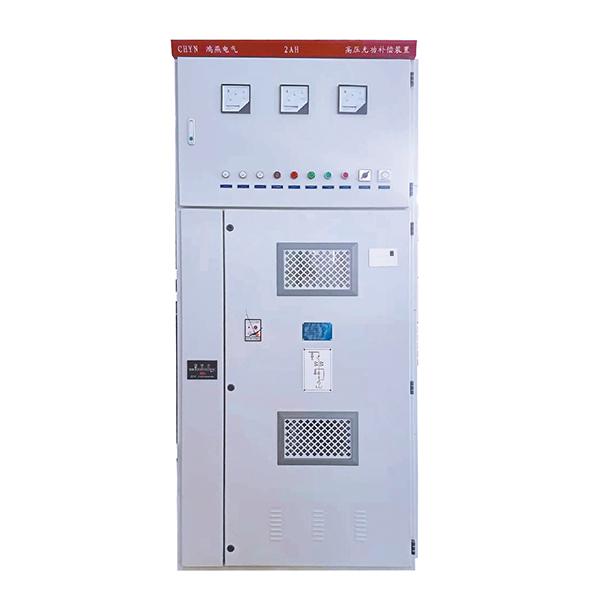Basic principles of high-voltage capacitor compensation cabinet: In actual power systems, most loads are asynchronous motors. Their equivalent circuit can be regarded as a series circuit of resistance and inductance, with a large phase difference between voltage and current and low power factor. When capacitors are connected in parallel, the capacitor current will offset part of the induced current, thereby reducing the induced current, reducing the total current, reducing the phase difference between voltage and current, and improving the power factor. 1. Capacitor cabinet switching process. When the capacitor cabinet is closed, the first part must be closed first, and then the second part; when closing, the opposite is true. Switching sequence for operating capacitor cabinets. Manual closing: close the isolation switch → switch the secondary control switch to the manual position and close each group of capacitors one by one. Manual opening: switch the secondary control switch to the manual position, open each group of capacitors one by one → break the isolation switch. Automatic closing: close the isolation switch → switch the secondary control switch to the automatic position, and the power compensator will automatically close the capacitor. Note: If you need to exit the capacitor cabinet during operation, you can press the reset button on the power compensator or turn the secondary control switch to zero to exit the capacitor. Do not use an isolation switch to exit a running capacitor directly! When manual or automatic switching, attention should be paid to repeated switching of the capacitor bank in a short period of time. The switching delay time should not be less than 30 seconds, preferably greater than 60 seconds, to allow sufficient discharge time for the capacitors. 2. Stop and supply power to the capacitor cabinet. Before supplying power to the capacitor cabinet, the circuit breaker should be in the open position, the command switch on the operation panel should be in the “Stop” position, and the power compensation controller switch should be in the “OFF” position. Only after the system is fully charged and running normally can power be supplied to the capacitor cabinet. Manual operation of the capacitor cabinet: close the circuit breaker of the capacitor cabinet, switch the command switch on the operation panel to positions 1 and 2, and manually connect the compensation of capacitors 1 and 2; turn the command switch to the “test” position, and the capacitor cabinet will Capacitor banks are tested. Automatic operation of the capacitor cabinet: close the circuit breaker of the capacitor cabinet, switch the command switch on the operation panel to the “automatic” position, close the power compensation controller switch (ON), and switch the command switch to the “run” position. ” position. The capacitor cabinet automatically compensates for the system’s reactive power according to the system settings. Manual compensation can only be used when the automatic compensation of the capacitor cabinet fails. When the command switch on the operation panel of the capacitor cabinet is switched to the “stop” position, the capacitor cabinet stops running. three. Additional information about capacitor cabinets. Why does the capacitor compensation cabinet not have an air switch but rely on a fuse for short circuit protection? Fuses are mainly used for short circuit protection, and fast fuses should be selected. Miniature circuit breakers (MCBs) have a different characteristic curve than fuses. The breaking capacity of MCB is too low (<=6000A). When an accident occurs, the response time of a miniature circuit breaker is not as fast as that of a fuse. When encountering high-order harmonics, the miniature circuit breaker cannot interrupt the load current, which may cause the switch to explode and be damaged. Because the fault current is too large, the contacts of the miniature circuit breaker may be burned out, making it impossible to break, expanding the scope of the fault. In severe cases, it may cause a short circuit or power outage in the entire plant. Therefore, MCB cannot be used as a replacement for fuses in capacitor cabinets. How the fuse works: The fuse is connected in series with the circuit being protected. Under normal circumstances, a fuse allows a certain amount of current to pass through. When a circuit is short-circuited or severely overloaded, a large fault current flows through the fuse. When the heat generated by the current reaches the melting point of the fuse, the fuse melts and cuts off the circuit, thereby achieving the purpose of protection. Most capacitor protection uses fuses to protect capacitors, and circuit breakers are rarely used, almost none. Selection of fuses to protect capacitors: The rated current of the fuse should not be less than 1.43 times the rated current of the capacitor, and should not be greater than 1.55 times the rated current of the capacitor. Check to see if your circuit breaker is undersized. The capacitor will generate a certain surge current when it is connected or disconnected, so the circuit breaker and fuse should be selected to be slightly larger.
Post time: Sep-14-2023